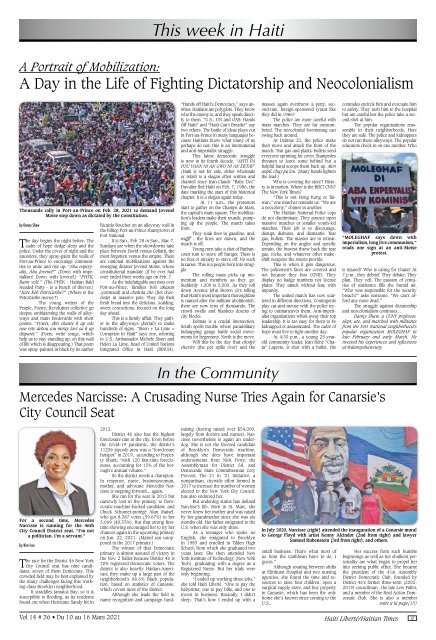Haiti Liberte 10 Mars 2021
Create successful ePaper yourself
Turn your PDF publications into a flip-book with our unique Google optimized e-Paper software.
This week in <strong>Haiti</strong><br />
A Portrait of Mobilization:<br />
A Day in the Life of Fighting Dictatorship and Neocolonialism<br />
Thousands rally in Port-au-Prince on Feb. 28, <strong>2021</strong> to demand Jovenel<br />
Moïse step down as dictated by the Constitution.<br />
by Danny Shaw<br />
The day begins the night before. The<br />
cadre of hope dodge sleep and the<br />
police. Under the cover of night and the<br />
ancestors, they spray-paint the walls of<br />
Port-au-Prince to encourage communities<br />
to unite and rise up: “Aba enperyalis,<br />
Aba Jovenel!” (Down with imperialism!<br />
Down with Jovenel.) “PHTK,<br />
Bann volè.” (The PHTK - <strong>Haiti</strong>an Bald<br />
Headed Party - is a bunch of thieves.)<br />
“Kote kòb PetroCaribe?” (Where is the<br />
PetroCaribe money?)<br />
The young writers of the<br />
People, Poetry, Revolution collective go<br />
deeper, emblazoning the walls of alleyways<br />
and main boulevards with short<br />
poems. “Powèt, ekri chante k ap ede<br />
nou rete debou sou miray lavi sa k ap<br />
disparèt.” (Poets, write songs, which<br />
help us to stay standing up, on this wall<br />
of life which is disappearing.) That poem<br />
was spray-painted in black by its author<br />
Ricardo Boucher on an alleyway wall in<br />
the hilltop Port-au-Prince shantytown of<br />
Fort National.<br />
It is Sun., Feb. 28 or Sun., Mar. 7.<br />
Sundays are when the showdowns take<br />
place between David versus Goliath, the<br />
most forgotten versus the empire. There<br />
are national mobilizations against the<br />
emerging dictator Jovenel Moïse, whose<br />
constitutional mandate (if he ever had<br />
one) ended three weeks ago on Feb. 7.<br />
As the indefatigable sun rises over<br />
Port-au-Prince, families boil akasan<br />
(cornmeal) and chokola cho (hot chocolate)<br />
in massive pots. They dip their<br />
fresh bread into the delicious, scalding,<br />
sweet concoctions, focused on the long<br />
day ahead.<br />
This is a family affair. They gather<br />
in the alleyways (koridò) to make<br />
hundreds of signs. “Sison + La Lime =<br />
Corruption in <strong>Haiti</strong>” says one, referring<br />
to U.S. Ambassador Michele Sison and<br />
Helen La Lime, head of United Nations<br />
Integrated Office in <strong>Haiti</strong> (BINUH).<br />
“Hands off <strong>Haiti</strong>’s Democracy,” says another.<br />
<strong>Haiti</strong>ans are polyglots. They know<br />
who the enemy is, and they speak directly<br />
to them. “U.S., UN and OAS: Hands<br />
Off <strong>Haiti</strong>” and “<strong>Haiti</strong> Can’t Breathe” say<br />
two others. The battle of ideas plays out<br />
in Port-au-Prince in many languages because<br />
<strong>Haiti</strong>ans know what many of us<br />
perhaps do not: this is an international<br />
and anti-imperialist struggle.<br />
This latest democratic struggle<br />
is now in its fourth decade. “AYITI PA<br />
POU VANN NI AN GWO NI AN DETAY”<br />
(<strong>Haiti</strong> is not for sale, either wholesale<br />
or retail) is a slogan often written and<br />
chanted since Jean-Claude “Baby Doc”<br />
Duvalier fled <strong>Haiti</strong> on Feb. 7, 1986, the<br />
date marking the start of this historical<br />
chapter. It is a slogan again today.<br />
At 11 a.m., the protestors<br />
start to gather on the Champs de <strong>Mars</strong>,<br />
the capital’s main square. The mobilization’s<br />
leaders make their rounds, pumping<br />
up the people. The march takes<br />
form.<br />
They soak tires in gasoline, and,<br />
wufff , the lines are drawn, and the<br />
march is off.<br />
Young men take a shot of Barbancourt<br />
rum to stave off hunger. There is<br />
no fear or anxiety to stave off. No such<br />
luxuries. This is a people born into struggle.<br />
The rolling mass picks up momentum<br />
and members as they go.<br />
Suddenly 1,000 is 5,000. As they roll<br />
down Avenue John Brown (it’s telling<br />
that <strong>Haiti</strong>’s most important thoroughfare<br />
is named after the militant abolitionist),<br />
there are now tens of thousands. The<br />
crowd swells and blankets dozens of<br />
city blocks.<br />
Delmas is a crucial intersection.<br />
South spells trouble where paramilitary<br />
kidnapping gangs battle social movements<br />
for hegemony. North is the move.<br />
Will this be the day that chodyè<br />
chavire (the pot spills over) and the<br />
masses again overthrow a petty, second-rate,<br />
foreign-sponsored tyrant like<br />
they did in 1986?<br />
The police are more careful with<br />
mass marches. They are far outnumbered.<br />
The neocolonial boomerang can<br />
swing back around.<br />
At Delmas 32, the police make<br />
their move and attack the front of the<br />
march. Tear gas and plastic bullets send<br />
everyone sprinting for cover. Stampedes<br />
threaten to leave some behind but a<br />
helpful hand scoops them back up. Men<br />
anpil, chay pa lou. (Many hands lighten<br />
the load.)<br />
Who is covering the story? History<br />
is in motion. Where is the BBC? CNN?<br />
The New York Times?<br />
“This is not Hong Kong or Taiwan,”<br />
one marcher reminds us. “We are<br />
a neocolony,” chimes in another.<br />
The <strong>Haiti</strong>an National Police cops<br />
do not discriminate. They pounce upon<br />
massive marches or smaller youth-led<br />
marches. Their job is to discourage,<br />
disrupt, disburse, and dismantle. Tear<br />
gas, bullets. The masses are in retreat.<br />
Depending on the angles and specific<br />
terrain, the bravest throw back the tear<br />
gas, rocks, and whatever other makeshift<br />
weapons the streets provide.<br />
This is when it gets dangerous.<br />
The policemen’s faces are covered and<br />
not because they fear COVID. They<br />
display no badge numbers nor license<br />
plates. They attack without fear, with<br />
impunity.<br />
The united march has now scattered<br />
in different directions. Contingents<br />
play cat-and-mouse with the police trying<br />
to outmaneuver them. Anti-imperialist<br />
organizations whisk away their top<br />
leadership. It is too easy for them to be<br />
kidnapped or assassinated. The cadre of<br />
hope must live to fight another day.<br />
At 4:30 p.m., a young 25-yearold<br />
community leader, Jean Réné “Chata”<br />
Laporte, is shot with a bullet. His<br />
comrades encircle him and evacuate him<br />
to safety. They rush him to the hospital<br />
but are careful lest the police take a second<br />
shot at him.<br />
The popular organizations reassemble<br />
in their neighborhoods. Here<br />
they are safe. The police and kidnappers<br />
do not run these alleyways. The popular<br />
educators check in on one another. Who<br />
“MOLEGHAF says down with<br />
imperialism, long live communism,”<br />
reads one sign at an anti-Moïse<br />
protest.<br />
is injured? Who is caring for Chata? At<br />
7 p.m., they debrief. They debate. They<br />
plan. They yell. The passion of centuries<br />
of resistance fills the humid air.<br />
“Who was responsible for the security<br />
breach?” asks someone. “We can’t afford<br />
any more dead.”<br />
The struggle against dictatorship<br />
and neocolonialism continues...<br />
Danny Shaw, a CUNY professor,<br />
slept, ate, and marched with militants<br />
from the Fort National neighborhood’s<br />
popular organization MOLEGHAF in<br />
late February and early March. He<br />
tweeted his experiences and reflections<br />
at @dannyshawcuny.<br />
In the Community<br />
Mercedes Narcisse: A Crusading Nurse Tries Again for Canarsie’s<br />
City Council Seat<br />
For a second time, Mercedes<br />
Narcisse is running for the 46th<br />
City Council District seat. “I’m not<br />
a politician. I’m a servant.”<br />
by Kim Ives<br />
The race for the District 46 New York<br />
City Council seat has nine candidates,<br />
seven of them Democrats. This<br />
crowded field may be best explained by<br />
the many challenges facing this working-class<br />
Brooklyn neighborhood.<br />
It straddles Jamaica Bay, so it is<br />
susceptible to flooding, as its residents<br />
found out when Hurricane Sandy hit in<br />
2012.<br />
District 46 also has the highest<br />
foreclosure rate in the city. Even before<br />
the Covid-19 pandemic, the district’s<br />
11236 zipcode area was a “foreclosure<br />
hotspot” in 2019, according to Property<br />
Shark, “with 120 first-time foreclosures,<br />
accounting for 15% of the borough’s<br />
annual volume.”<br />
So the district needs a champion.<br />
In response, nurse, businesswoman,<br />
mother, and advocate Mercedes Narcisse<br />
is stepping forward... again.<br />
She ran for the seat in 2013 but<br />
narrowly lost in the primary to Democratic-machine-backed-candidate<br />
and<br />
Chuck Schumer-protégé Alan Maisel,<br />
who got 8,387 votes (59.67%) to her<br />
5,669 (40.33%). But that strong firsttime<br />
showing encouraged her to try her<br />
chances again in the upcoming primary<br />
on Jun. 22, <strong>2021</strong>. (Maisel ran unopposed<br />
in the 2017 primary.)<br />
The winner of that Democratic<br />
primary is almost assured of victory in<br />
the Nov. 2 ballot because District 46 is<br />
70% registered Democratic voters. The<br />
district is also heavily <strong>Haiti</strong>an-American;<br />
they make up a large part of the<br />
neighborhood’s 86.6% Black population,<br />
based on statistics of Canarsie,<br />
which covers most of the district.<br />
Although she leads the field in<br />
name recognition and campaign fundraising<br />
(having raised over $54,000,<br />
largely from doctors and nurses), Narcisse<br />
nevertheless is again an underdog.<br />
She is not the favored candidate<br />
of Brooklyn’s Democratic machine,<br />
although she does have important<br />
endorsements from Nick Perry, the<br />
Assemblyman for District 58, and<br />
Democratic State Committeeman Cory<br />
Provost. The 21 in ’21 Initiative, a<br />
nonpartisan, citywide effort formed in<br />
2017 to increase the number of women<br />
elected to the New York City Council,<br />
has also endorsed her.<br />
But underdog status has defined<br />
Narcisse’s life. Born in St. Marc, she<br />
never knew her mother and was raised<br />
by her grandmother since she was six<br />
months old. Her father emigrated to the<br />
U.S. when she was only three.<br />
As a teenager who spoke no<br />
English, she emigrated to Brooklyn<br />
in 1983 and enrolled in Tilden High<br />
School, from which she graduated two<br />
years later. She then attended New<br />
York Institute of Technology (New York<br />
Tech), graduating with a degree as a<br />
Registered Nurse. But her trials were<br />
only beginning.<br />
“I ended up working three jobs,”<br />
she told Haïti Liberté. “One to pay the<br />
babysitter, one to pay bills, and one to<br />
invest in business. Basically, I didn’t<br />
sleep. That’s how I ended up with a<br />
In July 2020, Narcisse (right) attended the inauguration of a Canarsie mural<br />
to George Floyd with artist Kenny Alcindor (2nd from right) and lawyer<br />
Samuel Rubenstein (3rd from right), and others.<br />
small business. That’s what most of<br />
us from the Caribbean have to do, I<br />
guess.”<br />
Although rotating between shifts<br />
at Elmhurst Hospital and two nursing<br />
agencies, she found the time and resources<br />
to raise four children, open a<br />
surgical supply store, and buy property<br />
in Canarsie, which has been the only<br />
home she’s known since coming to the<br />
U.S..<br />
Her success from such humble<br />
beginnings as well as her ebullient personality<br />
are what began to propel her<br />
into seeking public office. She became<br />
the president of the 41st Assembly<br />
District Democratic Club, founded by<br />
District 46's former three-term (2002-<br />
2013) councilman , the late Lew Fidler,<br />
and a member of the Real Action Democratic<br />
Club. She is also a member<br />
suite à la page(15)<br />
Vol 14 # 36 • Du <strong>10</strong> au 16 <strong>Mars</strong> <strong>2021</strong><br />
<strong>Haiti</strong> Liberté/<strong>Haiti</strong>an Times<br />
9
















